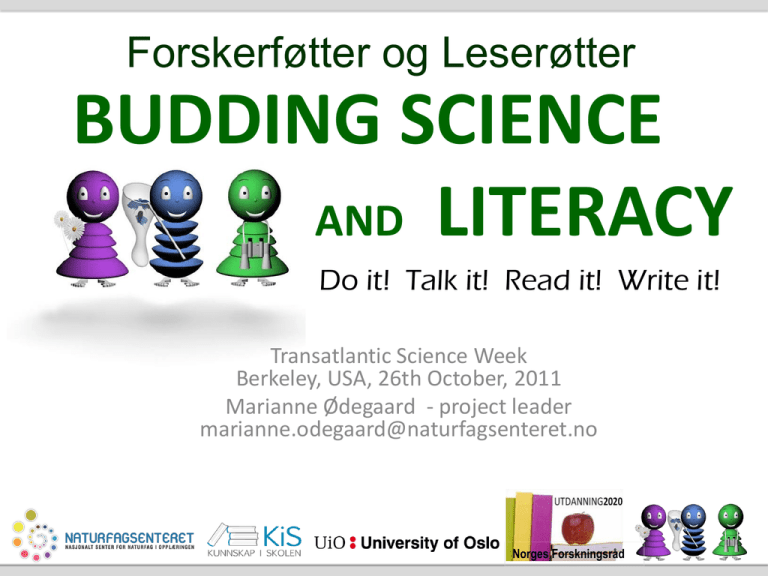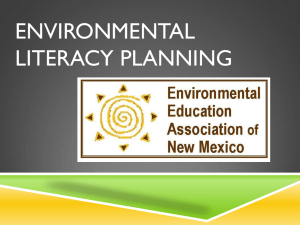Ødegaard
advertisement

Forskerføtter og Leserøtter BUDDING SCIENCE AND LITERACY Do it! Talk it! Read it! Write it! Transatlantic Science Week Berkeley, USA, 26th October, 2011 Marianne Ødegaard - project leader marianne.odegaard@naturfagsenteret.no Norges Forskningsråd Seeds of Science. Roots of Reading • Do it Talk it Read it Write it • Literacy activities integrated in inquiry-based science • The child’s own creativity meets scientific creativity! ”How do we resemble scientists?” Motivation for study • The Knowledge Promotion Reform : Budding scientist Basic skills • Inquiry-based science ”Inquiry into authentic questions generated from student experiences is the central strategy for science teaching.” Anderson, 2007 • Science and literacy ”Learning the language of science is a major part of science education.” Wellington & Osborne, 2001; Mortimer & Scott, 2003 Challenges & Paradoxes • The detailed procedures • A step by step, detailed ensure more open-ended Teacher Guide – very rich and creative tasks for in words! students • Norwegian teachers are used to more freedom when teaching a subject. • Norwegian teachers in primary do not have much education in science. • US-context • Where do units fit the Norwegian curriculum? Research-based development • Starting point: Professional development course for teachers: ”Science and basic skills” • Combines teachers’ professional competence from the classroom with researchers’ knowledge of science education • Together we try out, translate and later adapt curriculum material developed at University of California, Berkeley - Lawrence Hall of Science Budding Science and Literacy A longitudinal design-based study of using inquiry-based science and literacy in comprehensive schooling • Aim: To study how the interplay of indoor/outdoor inquiry-based science activities and literacy activities can improve teachers’ instructional competence and students’ learning outcome in science. • We design: The Budding Science and Literacy Teaching Model Iterative design teaching improved teaching Professional development cohort 1 teaching S&R improved teaching Professional development cohort 2 teaching S&R improved teaching Professional development cohort 3 Improving the teaching model teaching improved teaching teaching S&R improved teaching Professional Professional development development cohort 1 cohort 2 teaching S&R Professional development cohort 3 Improving the teaching model Course assignments: Written descriptions and presentations Classroom observations Classroom studies: 6 teachers in 4 schools + their students (1.- 5. grade) Videoobservations Interviews (teacher + students) Classroom assignments improved teaching ???? BUDDING SCIENCE AND LITERACY Explicit teaching Systematic variation of inquiry-based activities Teaching model: (researchbased draft) (Ødegaard, Frøyland and Mork, 2011) • Multi-modal learning activities: Do-it. Read-it. Write-it. Talk-it. • Firsthand- and secondhand investigations • Multiple learning arenas • Synergy effects of inquiries in science and literacy •Formative assessment Explicit teaching Systematic variation of inquiry-based activities • Few concepts BUDDING SCIENCE AND LITERACY • Modeling learning strategies Teaching • Multi-modal learning The good thing withactivities: this teaching model is that Do-it. Read-it. model: Write-it. Talk-it. it gives support to the low achievers and (Ødegaard, Frøyland and Mork, 2011) •Explicit end product • Firsthandand secondchallenges the high achievers. (researchhand investigations Teacher, 4th grade based draft) • Multiple learning arenas • Synergy effects of inquiries in science and literacy •Nature of Science • Why are teachers so content with the teaching model/material? • Why do students think this kind of learning is fun? Searching for quality! gathering and analysing data It’s not so much what they do, but the quality of how they do it. (from PISA+ Ødegaard & Klette, 2011) BUDDING SCIENCE AND LITERACY Systematic variation of inquiry-based activities • Multi-modal learning activities: Do-it. Read-it. Write-it. Talk-it. • Firsthand- and secondhand investigations • Multiple learning arenas • Synergy effects of inquiries in science and literacy •Nature of Science (Ødegaard, Frøyland og Mork, 2011) • Modeling learning strategies • Few concepts •Formative assessment •Explicit end product Research project: Explicit teaching Trying out Seeds and Roots: • Unit: • Read it (3.klasse) Wondering about what things are made of and why. • Do it • Write it Students make their own glue for glueing beans on paper. Students write down the receipe • Talk it Which glue is best? And why?? Beginning to analyse videos: 70 60 50 Individual 40 Group 30 Whole class 20 10 0 Writing Reading Talking Doing (Pilot analysis from one lesson) Searching for incidents for in-depth analysis: Timeline for one pilot lesson: Reading Writing Talking Doing Interesting? Reading whole class Writing individual Writing whole class Talking whole class Talking group/pair Talking ind. presenting Doing whole class Doing group/pair Doing individual Preliminary findings (PhD study): Linking everyday and scientific language Gard Ove Sørvik (2011) • A focus on a few key concepts seem to support “link-making” (Scott et al. 2011) in the on-going meaning making interaction of the classroom. • The concept of systems appears to be especially valuable in this regard as it functions as a link-making tool across discourses for the students—linking their everyday ways of talking and thinking to the language of school science—and in the process of forming conceptual webs (Howe 1996). • Students down to the year 1 appropriated the concept of systems. • The notion of systems may be important to consider in terms of big or key ideas in science (Harlen 2010) or alternately as a key idea for science in schools. How teachers know what students understand Teachers’ formative assessment of student understanding of scientific concepts Berit Haug, PhD-student Findings based on interviews with elementary school teachers In general: “It’s hard to explain why I know the students know, it -ongoing assessment of student understanding of scientific concepts is is a gut feeling.” (15the years of teaching experience) a spontaneousTeacher act that teachers find hard to articulate -the selection of concepts to explain is based upon the teachers’ implicit presupposition of students’ knowledgebase “To focus on few concepts help me guide the students in After implementing Seeds/Roots the right direction, and I knowmaterial what to look for when assessing understanding.” -the selection of their key concepts provides a direction and makes it easier of focus the teachers to know Several what to upon -introducing the concepts through writing, reading, doing and talking make students’ thinking and understanding visible, hence easier to assess Some system! Before I just said things, now I can call them systems! Student, 4th grade (9 years) Thank you! marianne.odegaard@naturfagsenteret.no








